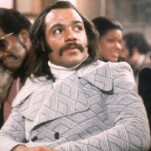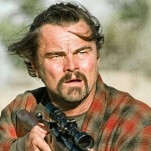Ben Kingsley traded the saintliness of Gandhi for the vulgar gangster menace of Sexy Beast

Watch This offers movie recommendations inspired by new releases, premieres, current events, or occasionally just our own inscrutable whims. This week: With the Russell Crowe road-rage thriller Unhinged racing (unwisely) into theaters, we’re looking back on other films that cast movie stars as psychopaths.
Sexy Beast (2000)
To say that the indelible psycho gangster Don Logan looms large over Jonathan Glazer’s debut feature Sexy Beast would be an understatement. We spend most of the first hour of this compact, idiosyncratic crime drama wondering what he might be capable of and part of the rest guessing where he went. He is intimidating, childish, unpredictable, repulsive, stubborn, and—as portrayed by Ben Kingsley—quotably funny, speaking a Harold Pinteresque staccato of insults and threats. With his shaved head and strange affect, he is the embodiment of the repressed violence that has come back into the life of the retired London thief Gal Dove (Ray Winstone).
As Sexy Beast opens, Gal and his ex-porn-star wife, Deedee (Amanda Redman), are living comfortably in the southern part of Spain, which is basically Florida for English criminals. This is a lazily comfortable existence, but its imminent, disastrous disruption is starkly foreshadowed by the giant boulder that rolls into the Doves’ property in the opening scene, landing on the heart-shaped mosaic in their swimming pool. Over dinner, Gal and Deedee’s similarly super-tanned friends Aitch (Cavan Kendall) and Jackie (Julianne White) reveal that their mutual acquaintance Don is flying from London, which is enough to make everyone’s skin crawl. Only later will we learn the reason behind his visit: He has come to bully Gal into taking part in a vault heist planned by the sinister criminal mastermind Teddy Bass (Ian McShane).
Like Glazer’s subsequent features, Birth and Under The Skin, Sexy Beast is ultimately about an intrusive presence calculated to make viewers squirm. Anyone who’s seen those movies may recognize other currents, among them pervasive sexual discomfort and a taste for the surreal (which in this case extends to some memorably strange dream sequences involving a killer rabbit). But while Glazer’s later works operate in a sustained eerie atmosphere, this one is defined by sudden, electrifying changes in pitch and tone. These include Don’s arrival; a heist plan explained via a zigzagging mile-a-minute montage that rips open the movie’s otherwise deliberate pacing; and a third act that unexpectedly leaps forward in space and time.








































